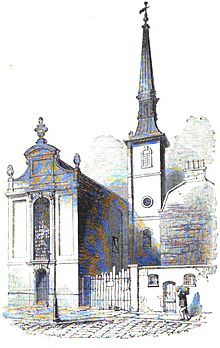St Mildred, Bread Street
| St. Mildred, Bread Street | |
|---|---|
 |
|
| Location | London |
| Country | United Kingdom |
| Denomination | Church of England |
| History | |
| Founded | 1677-83 |
| Architecture | |
| Architect(s) | Christopher Wren |
| Style | Baroque |
The church of St Mildred, Bread Street, stood on the east side of Bread Street in the Bread Street Ward of the City of London. It was dedicated to the 7th century Saint Mildred the Virgin, daughter of Merewald, sub-king of the West Mercians. Of medieval origin, the church was rebuilt to the designs of Sir Christopher Wren following its destruction in the Great Fire of London in 1666. One of the few City churches to retain Wren's original fittings into the 20th century, St Mildred's was destroyed by bombs in 1941.
The earliest record of the church of St Mildred is of its rebuilding in around 1300. This was probably paid for by Lord Trenchaunt of St. Albans, who was buried in the Church at about that time. Sir John Shadworth, Lord Mayor in 1401, who was also buried in the church, gave a parsonage house, a vestry and a churchyard. A description by John Strype indicates that the medieval church was an aisled building, with a clerestory. The patronage of the church belonged to the monastery of St Mary Overie until 1533, when it passed into private hands.
Strype records that the church was repaired throughout in 1628, when most of the north wall, the nave arcades and the windows above them were rebuilt. A major benefactor of the church during the 17th century was Sir Nicholas Crisp, a wealthy merchant and ardent supporter of Charles I, who, by 1663, owned the advowson of the church. His gifts included two large silver flagons, which were still in use into the 20th century, and a five light stained glass east window depicting the Spanish Armada, Elizabeth I, the Gunpowder Plot, the plague of 1625, and portraits of himself, his wife and children. He was interred in his family vault in the church, although his heart was buried at Hammersmith.
St Mildred's was destroyed in the Great Fire of London of 1666. Its silver plate, however, survived, having been taken to safety in Hackney in a hired carriage. After the fire the parish of the church of St Margaret Moses, which was also destroyed but not rebuilt, was united to that of St Mildred.
...
Wikipedia
